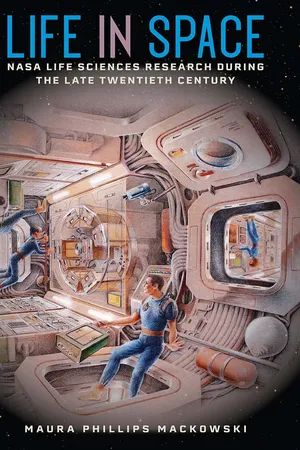
Life in Space
NASA Life Sciences Research during the Late Twentieth Century
- English
- ePUB (mobile friendly)
- Available on iOS & Android
About this book
A little-known yet critical part of NASA history
Life in Space explores the many aspects and outcomes of NASA’s research in life sciences, a little-understood endeavor that has often been overlooked in histories of the space agency. Maura Mackowski details NASA’s work in this field from spectacular promises made during the Reagan era to the major new directions set by George W. Bush’s Vision for Space Exploration in the early twenty-first century.
At the first flight of NASA’s space shuttle in 1981, hopes ran high for the shuttle program to achieve its potential of regularly transporting humans, cargo, and scientific experiments between Earth and the International Space Station. Mackowski describes different programs, projects, and policies initiated across NASA centers and headquarters in the following decades to advance research into human safety and habitation, plant and animal biology, and commercial biomaterials. Mackowski illuminates these ventures in fascinating detail by drawing on rare archival sources, oral histories, interviews, and site visits.
While highlighting significant achievements and innovations such as space radiation research and the Neurolab Spacelab Mission, Mackowski reveals frustrations—lost opportunities, stagnation, and dead ends—stemming from frequent changes in presidential administrations and policies. For today’s dreams of lunar outposts or long-term spaceflight to become reality, Mackowski argues, a robust program in space life sciences is essential, and the history in this book offers lessons to help prevent leaving more expectations unfulfilled.
Frequently asked questions
- Essential is ideal for learners and professionals who enjoy exploring a wide range of subjects. Access the Essential Library with 800,000+ trusted titles and best-sellers across business, personal growth, and the humanities. Includes unlimited reading time and Standard Read Aloud voice.
- Complete: Perfect for advanced learners and researchers needing full, unrestricted access. Unlock 1.4M+ books across hundreds of subjects, including academic and specialized titles. The Complete Plan also includes advanced features like Premium Read Aloud and Research Assistant.
Please note we cannot support devices running on iOS 13 and Android 7 or earlier. Learn more about using the app.
Information
Table of contents
- Cover
- Title Page
- Copyright Page
- Dedication
- Contents
- List of Abbreviations and Acronyms
- Acknowledgments
- Introduction
- 1. Everyone’s a Scientist: Students, Industry, and Partners in Space
- 2. Working in the Space Environment
- 3. Safety, Science, and Operational Medicine: Shuttle and Station in the 1980s and 1990s
- 4. Science and Scientists: Peer Review, the Extended Duration Orbiter Medical Project, Neurolab, and a Station Centrifuge
- 5. Organizing in the 1980s–1990s: Ethics, Institutes, and Biological Modeling
- 6. Radiation and the Science of Risk Reduction
- 7. Design and Redesign: The Many Space Stations of NASA
- 8. The Cold War and Its Aftermath: Scientific Exchange, Social Change
- 9. More People, Less Science, Less NASA? International Participants, Centrifuge, and Nongovernmental Organizations
- 10. The Vision for Space Exploration
- Parting Thoughts
- Notes
- Selected Bibliography
- Index